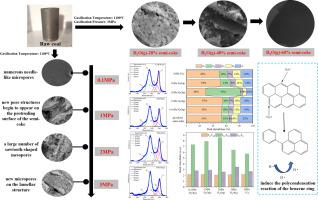煤深埋地下气化条件下蒸汽气氛下半焦孔隙结构演化
IF 7.7
2区 工程技术
Q1 CHEMISTRY, APPLIED
引用次数: 0
摘要
煤炭地下气化是深部煤炭资源就地清洁转化的重要途径之一。受地下水涌入的影响,蒸汽气化成为UCG工艺合成气生产的主导反应。研究了半焦在常压~ 3mpa蒸汽气氛下的加压产气特性。采用氮气吸附-解吸、SEM、AFM、拉曼光谱等方法对气化后的残焦进行表征,分析半焦孔隙结构和官能团随压力和碳转化率变化的演变。结果表明:在水蒸气的作用下,半焦表面在1 nm以下形成了丰富的微孔结构;在3 MPa下,微孔比表面积由17.64 m2/g增加到435.46 m2/g,是CO₂气氛下的4倍。微孔是蒸汽气化初始反应的主要场所。基于官能团的半焦结构的演化是压力主导的链裂解和H自由基主导的缩聚竞争的结果。研究结果为地下水影响下深部煤气化制氢过程的强化提供了理论依据。本文章由计算机程序翻译,如有差异,请以英文原文为准。

Pore structure evolution of semi-coke under steam atmosphere in the context of deep underground coal gasification
Underground coal gasification (UCG) is one of the important ways for in-situ clean conversion of deep coal resources. Affected by groundwater influx, steam gasification becomes the dominant reaction for syngas production in the UCG process. This paper investigates the pressurized gas production characteristics of semi-coke under steam atmosphere range from atmospheric to 3 MPa. The gasified residual coke is characterized by N2 adsorption-desorption, SEM, AFM, and Raman spectroscopy to analyze the evolution of pore structure and functional groups of semi-coke with changes in pressure and carbon conversion rate. The results show that the action of steam leads to the development of abundant microporous structures below 1 nm on the semi-coke surface. Under 3 MPa, the specific surface area of micropores increases from 17.64 m2/g to 435.46 m2/g, which is 4 times that under CO₂ atmosphere. Micropores serve as the main site for the initial reaction of steam gasification. Evolution of semi-coke structure based on functional groups is the result of competition between pressure-dominated chain scission and H radical-dominated polycondensation. The research results provide a theoretical basis for strengthening the hydrogen production process of deep underground coal gasification affected by groundwater.
求助全文
通过发布文献求助,成功后即可免费获取论文全文。
去求助
来源期刊

Fuel Processing Technology
工程技术-工程:化工
CiteScore
13.20
自引率
9.30%
发文量
398
审稿时长
26 days
期刊介绍:
Fuel Processing Technology (FPT) deals with the scientific and technological aspects of converting fossil and renewable resources to clean fuels, value-added chemicals, fuel-related advanced carbon materials and by-products. In addition to the traditional non-nuclear fossil fuels, biomass and wastes, papers on the integration of renewables such as solar and wind energy and energy storage into the fuel processing processes, as well as papers on the production and conversion of non-carbon-containing fuels such as hydrogen and ammonia, are also welcome. While chemical conversion is emphasized, papers on advanced physical conversion processes are also considered for publication in FPT. Papers on the fundamental aspects of fuel structure and properties will also be considered.
 求助内容:
求助内容: 应助结果提醒方式:
应助结果提醒方式:


